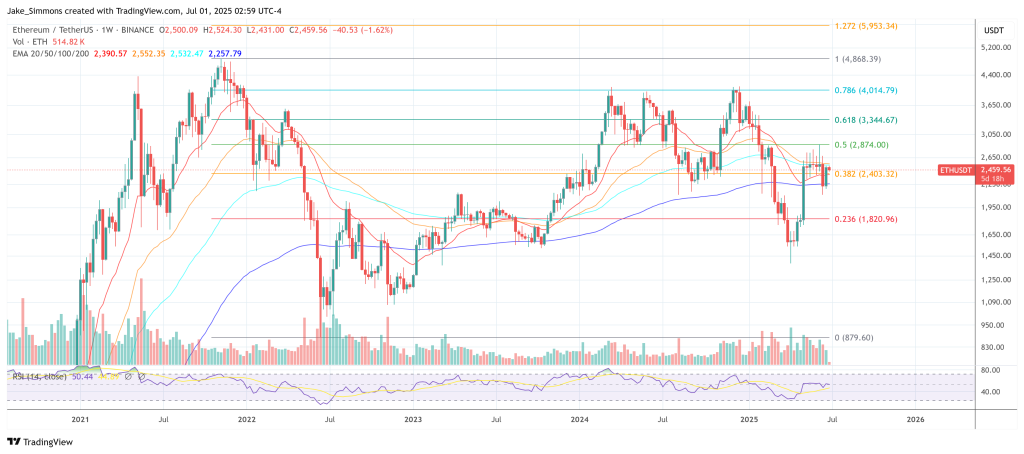Tom Lee’s Bold Ethereum Bet: Why ETH Could Be Crypto’s Next MicroStrategy-Style Rocket
Wall Street's crypto bull Tom Lee just placed his flag on Ethereum—and the market's buzzing. Could this be ETH's MicroStrategy moment?
Fundstrat's fearless forecaster is doubling down on ETH's surge potential, betting against the skeptics who still think crypto winters last forever. The playbook? Straight out of Michael Saylor's BTC accumulation strategy—but with smarter gas fees.
Why institutions are quietly loading up
While retail traders panic-sell memecoins, smart money's building ETH positions like it's 2021 again. Lee's call echoes through trading desks: Ethereum's fundamentals now outpace its price.
The cynical kicker: Of course this happens right after your average finance bro finally capitulated and sold his ETH bag at a loss. The market always punishes the impatient.
Tom Lee Goes Full MicroStrategy On Ethereum
Speaking hours later on CNBC’s Squawk Box, Lee framed the pivot as a logical response to the explosive growth of stablecoins, most of which settle on Ethereum. “Stablecoins, which is the ChatGPT of crypto, because it’s viral adoption by consumers, businesses, banks and now even Visa,” he said, underscoring why a treasury heavy in ETH could become strategically indispensable. Ethereum’s proof-of-stake design means that large holders who validate blocks “secure the fidelity of stablecoins,” Lee continued. “When Goldman issues a stablecoin and JP Morgan [issues] it on Ethereum as a layer-one blockchain, they’re going to want to secure it by staking Ethereum.”
Lee tied the long-term upside to macro numbers the US Treasury itself has started to cite. Stablecoins today hover around $250 billion; Treasury Secretary Scott Bessent recently suggested the figure could hit $2 trillion—a potential ten-fold expansion that, in Lee’s words, WOULD “insure dollar dominance.” Because Ethereum already underpins more than half of stable-value tokens, a multi-trillion-dollar stablecoin market would translate directly into rising transaction fees for the network and, by extension, higher staking rewards for BitMine’s planned validator clusters.
The private-placement syndicate reads like a who’s-who roster from both TradFi and crypto: MOZAYYX led the round, joined by Founders Fund, Pantera, FalconX, Republic Digital, Kraken, Galaxy Digital, Digital Currency Group, Diametric Capital and Occam Crest. Closing is expected on or about 3 July, subject to NYSE American approval. BitMine, headquartered in Las Vegas, will immediately deploy the ETH position into staking, giving the miner a yield-bearing balance-sheet asset while reinforcing Ethereum’s security budget. “One of the key performance metrics for BitMine going forward is to increase the value of ETH held per share,” chief executive Jonathan Bates said in the statement.
For investors, the comparison with MicroStrategy is unavoidable but imperfect. Saylor’s company amassed Bitcoin under a proof-of-work regime that offers no native yield; BitMine’s ether can generate income through both staking rewards and potential capital-markets transactions collateralized by those staked coins.
Yet both strategies share a central bet: that a scarce digital asset sitting at the Core of global finance will appreciate faster than cash alternatives on a corporate balance sheet. Whether BitMine achieves MicroStrategy-level returns will depend on execution, regulatory clarity for staking, and—most of all—Ethereum’s price path. What is clear, however, is that corporate treasuries are beginning to see ether not merely as “gas” for decentralized applications but as a strategic reserve asset in its own right.
From a market-structure vantage, the new treasury model could translate into meaningful price torque for Ether if it scales. MicroStrategy’s serial purchases have now absorbed nearly 600,000 BTC—around 2.8 percent of the 21 million-coin cap—and coincided with Bitcoin’s ascent from roughly $11,000 in August 2020, when the company made its first buy, to more than $107,000 today, a near-ten-fold move.
BitMine’s opening salvo—$250 million, or about 100,000 ETH at current prices—represents barely 0.08 percent of Ethereum’s 122 million-coin supply, yet roughly 28 percent of that supply is already locked in staking contracts while net issuance has turned negative post-EIP-1559, shrinking the freely tradable float. If even a handful of additional balance sheets emulate this “ETH-as-reserve” playbook, the resulting demand shock could replicate the supply-squeeze dynamics that propelled bitcoin into six-figure territory.
At press time, Ether traded at $2,459.


